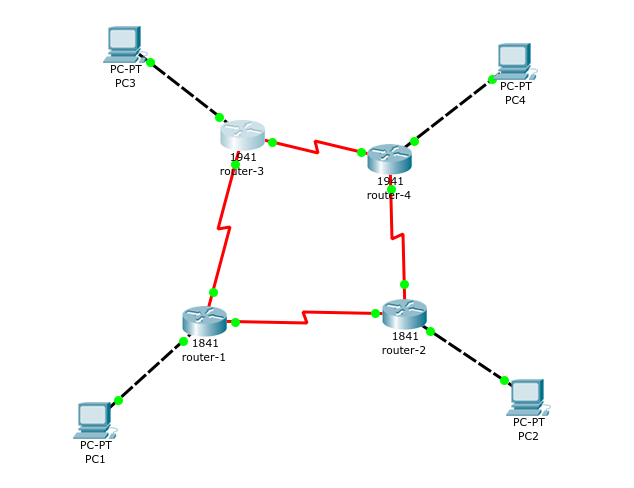dynamic routing: RIPv2
-
dynamisch en redundant
We kunnen de oefening, static routing 2, redundant maken zoals we dit al deden in static routing 3.
Maar dit heeft een kostprijs:
per extra router komen er een factor statische routes bij. Bij volledige redundancy is dit aantal routes evenredig met de faculteit van het aantal routers:
4 routers geeft 4! = 1 x 2 x 3 x 4 = 24 statische routes
5 routers geeft 5! = 1 x 2 x 3 x 4 x 5 = 120 statische routes
Dit probleem oplossen kan mits gebruik van dynamische routing protocollen, zoalsRIP(Routing Information Protocol),OSPF(Open Shortest-Path First) enEIGRP(Enhanced Interior Gateway Routing Protocol.
In deze oefening kijken we even naarRIP versie 2: een eenvoudig in te stellen routing protocol.
We gebruiken opnieuw de physische configuratie van de vorige 2 oefeningen (static route 2 en 3)
Klik hiernaast op de PT-link om het sjabloon te downloaden: 4routers-addressing-ok
- configuratie
Om RIP versie 2 te gebruiken moeten we in cisco routers de volgende commando's intikken:R1(config)# router rip R1(config-router)# version 2 R1(config-router)# no auto-summary
Vervolgens moeten we alle netwerken die op router R1 zijn aangesloten classfull en zonder netmask, intikken:R1(config-router)# network 10.0.0.0 R1(config-router)# network 192.168.1.0 R1(config-router)# exit
We herhalen deze reeks op alle routers ... als volgt:
op router R2:R2(config)# router rip R2(config-router)# version 2 R2(config-router)# no auto-summary R2(config-router)# network 10.0.0.0 R2(config-router)# network 192.168.2.0 R2(config-router)# exit
op router R3:R3(config)# router rip R3(config-router)# version 2 R3(config-router)# no auto-summary R3(config-router)# network 10.0.0.0 R3(config-router)# network 192.168.3.0 R3(config-router)# exit
en op router R4:R4(config)# router rip R4(config-router)# version 2 R4(config-router)# no auto-summary R4(config-router)# network 10.0.0.0 R4(config-router)# network 192.168.4.0 R4(config-router)# exitVergeet niet telkens je nieuwe configuratie op te slaan.
- testen
- Test op PC-1 (of een andere) en
pingnaar alle andere PC's.
- Monitor tijdens de volgende test met een
ping -t <ip-address>op bijvoorbeeld PC-1
Verwijder nu in je netwerk, één van de seriële verbindingen, en kijk op je ping-monitor of alles blijft werken.
Verwijder een tweede lijn, en verbindt de eerste terug. Kijk op je monitor om te zien wat er gebeurt.
- Test op PC-1 (of een andere) en
- routing table
Op de routers kun je de routing table zichtbaar maken als volgt:
R1# show ip route
routes die beginnen met R zijn toegevoegd door RIPv2
routes die beginnen met C zijn rechtstreeks connected via een netwerkkaart van de router:Codes: C - connected, S - static, I - IGRP, R - RIP, M - mobile, B - BGP D - EIGRP, EX - EIGRP external, O - OSPF, IA - OSPF inter area N1 - OSPF NSSA external type 1, N2 - OSPF NSSA external type 2 E1 - OSPF external type 1, E2 - OSPF external type 2, E - EGP i - IS-IS, L1 - IS-IS level-1, L2 - IS-IS level-2, ia - IS-IS inter area * - candidate default, U - per-user static route, o - ODR P - periodic downloaded static route Gateway of last resort is not set 10.0.0.0/30 is subnetted, 4 subnets C 10.255.255.0 is directly connected, Serial0/0/0 C 10.255.255.4 is directly connected, Serial0/0/1 R 10.255.255.8 [120/1] via 10.255.255.6, 00:00:17, Serial0/0/1 R 10.255.255.12 [120/1] via 10.255.255.2, 00:00:13, Serial0/0/0 C 192.168.1.0/24 is directly connected, FastEthernet0/0 R 192.168.2.0/24 [120/1] via 10.255.255.2, 00:00:13, Serial0/0/0 R 192.168.3.0/24 [120/1] via 10.255.255.6, 00:00:17, Serial0/0/1 R 192.168.4.0/24 [120/2] via 10.255.255.6, 00:00:17, Serial0/0/1 [120/2] via 10.255.255.2, 00:00:13, Serial0/0/0
je kan het ook oplossen met OSPF als je de volgende configs paste in de correcte router:
!! R1 en conf t router ospf 1 network 10.255.255.0 0.0.0.3 area 0 network 10.255.255.4 0.0.0.3 area 0 network 192.168.1.0 0.0.0.255 area 0 end copy run start!! R2 en conf t router ospf 1 network 10.255.255.0 0.0.0.3 area 0 network 10.255.255.12 0.0.0.3 area 0 network 192.168.2.0 0.0.0.255 area 0 end copy run start!! R3 en conf t router ospf 1 network 10.255.255.4 0.0.0.3 area 0 network 10.255.255.8 0.0.0.3 area 0 network 192.168.3.0 0.0.0.255 area 0 end copy run start!! R4 en conf t router ospf 1 network 10.255.255.12 0.0.0.3 area 0 network 10.255.255.8 0.0.0.3 area 0 network 192.168.4.0 0.0.0.255 area 0 end copy run start